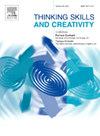The inner mechanism of creativity advantages of Southeast Asian-Taiwanese bicultural children: The mediating roles of shyness and shame
IF 3.7
2区 教育学
Q1 Social Sciences
引用次数: 0
Abstract
With bicultural identities and growth backgrounds, bicultural children have creativity advantages. Previous studies have examined how cognitive attributes enhance the creativity of bicultural children, but few studies have explored how affective attributes enhance creativity. This study considers both cognitive and affective attributes to build a more complete picture of creativity advantages. Previous studies have identified shyness and shame as possible factors affecting individual creativity, with lower degrees of shyness contributing to creativity and shame inhibiting creativity. In this study, the mediating roles of shyness and shame were explored to understand the possible mechanism of creativity advantages in new immigrant ethnic groups. Southeast Asian-Taiwanese bicultural children (n = 157) and native Taiwanese children (n = 354) were selected as subjects. (1) Regarding creative personality, Southeast Asian-Taiwanese bicultural children were better than native children, with shyness playing a mediating role. (2) Regarding creative tendency, Southeast Asian-Taiwanese bicultural children had better imagination than did native children, with shyness playing a mediating role. Additionally, Southeast Asian-Taiwanese bicultural children were more adventurous than were native children, with shame playing a mediating role. (3) Regarding creative thinking, degree of shyness and shame of Southeast Asian-Taiwanese bicultural children did not affect creative thinking. The findings provide deeper insight into the effects of shyness and shame within ethnic groups on differential creativity. Additionally, the study highlights the influence of affective traits in Southeast Asian bicultural children when exploring the impact of multicultural experiences on creativity. Focusing on the strengths of bicultural children, the study suggests that educational initiatives should be tailored to encourage children to leverage their unique strengths effectively.
求助全文
约1分钟内获得全文
求助全文
来源期刊

Thinking Skills and Creativity
EDUCATION & EDUCATIONAL RESEARCH-
CiteScore
6.40
自引率
16.20%
发文量
172
审稿时长
76 days
期刊介绍:
Thinking Skills and Creativity is a new journal providing a peer-reviewed forum for communication and debate for the community of researchers interested in teaching for thinking and creativity. Papers may represent a variety of theoretical perspectives and methodological approaches and may relate to any age level in a diversity of settings: formal and informal, education and work-based.
 求助内容:
求助内容: 应助结果提醒方式:
应助结果提醒方式:


